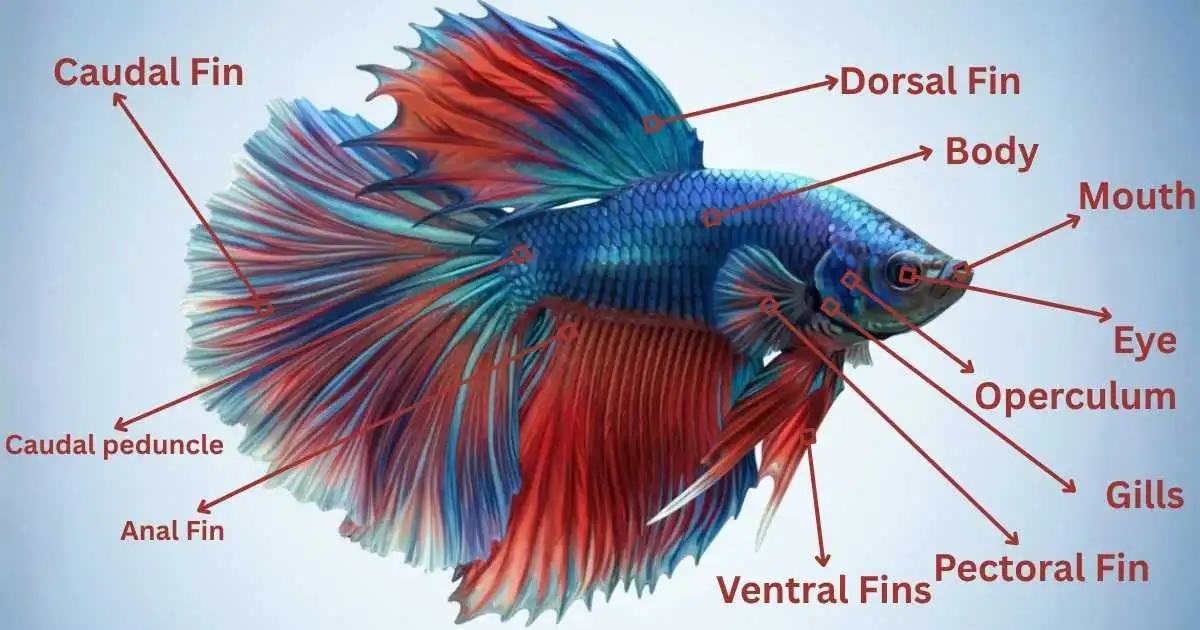Understanding betta fish anatomy changed everything about how I care for my bettas. When my betta Apollo developed cloudy eyes last year, I knew exactly what to look for because I’d studied his eye structure. That knowledge helped me catch popeye disease early and get him proper treatment. Knowing your betta’s body parts isn’t just interesting—it can literally save your fish’s life.
Betta fish anatomy is remarkably complex for such a small creature. These stunning fish have specialized organs like the labyrinth organ that sets them apart from other aquarium fish. From their flowing fins to their internal organs, each part plays a crucial role in keeping your betta healthy and active. Let’s explore what makes these magnificent fish tick, from head to tail.
Quick Summary: Betta Fish Body Parts
| Body Part | Primary Function | Health Indicator |
| Labyrinth Organ | Breathes atmospheric air | Gasping at surface excessively |
| Caudal Fin | Propulsion and swimming | Fin rot, tears, clamping |
| Dorsal Fin | Stability and balance | Deterioration, clamping |
| Gills | Extract oxygen from water | Rapid breathing, inflammation |
| Swim Bladder | Buoyancy control | Swimming sideways, floating |
| Eyes | Vision and hunting | Cloudiness, bulging, popeye |
| Operculum | Protects gills, displays beard | Damaged plates, stuck open |
External Betta Fish Anatomy: What You Can See
Understanding Betta Fish Eyes
Betta fish eyes sit on each side of their head, giving them nearly 360-degree vision. The center iris appears dark black while the outer portion varies in color. I’ve noticed my betta Luna has golden rings around her pupils that shine under aquarium lights. Pretty cool, right?
Your betta’s eyesight works well up to about 12-14 inches away. Beyond that, they’re quite nearsighted. This explains why they recognize you at feeding time but might not react to movement across the room. Bettas see in full color and don’t have eyelids, so they sleep with their eyes open. When you see your fish resting at the bottom with open eyes, don’t worry—that’s totally normal sleeping behavior for them.
[Internal link opportunity: Link to “Betta Fish Lifespan” article here]
Watch for eye health issues like popeye disease, which causes the eye to bulge outward. Cloudy eyes often signal poor water quality or bacterial infection. According to research published in Comparative Medicine, maintaining proper water quality is essential for preventing eye problems and other health issues in bettas.
The Unique Betta Fish Mouth Structure
Here’s something wild—betta fish jaws are proportionally stronger than a great white shark’s bite. Obviously they can’t hurt humans, but their mouth structure is designed for grabbing prey at the water surface. That upward-facing mouth isn’t just for looks. It evolved specifically so bettas could gulp air and catch insects floating on the water.
Inside that small mouth, bettas have rows of tiny sharp teeth on their lower jaw. These teeth help break down food before swallowing. Male bettas use their mouths during breeding to gently collect eggs from the tank bottom without crushing them. My male betta Perseus amazed me during his first spawn—he carefully carried dozens of eggs in his mouth without damaging a single one.
Operculum and the Famous Betta Beard
The operculum acts like a protective shield covering your betta’s delicate gills. Male bettas have a special membrane under these gill plates called the beard. When males flare to show dominance or feel threatened, they open their gill covers wide and extend this beard outward. It makes them look twice their actual size.
Female betta anatomy includes a beard too, but it’s barely visible compared to males. Most beards appear dark-colored unless your betta has very light coloring. I learned this watching my white betta Frost flare—his beard matches his pale body color perfectly, making it harder to spot than my darker bettas’ beards.
Betta Gills and Respiratory System
Betta gill structure works similarly to other fish, extracting dissolved oxygen from water as it passes through. But here’s where bettas get interesting—they can’t rely on gills alone. The gill tissue in anabantoid fish is actually weaker than in other species. This evolutionary trade-off happened because bettas developed that amazing labyrinth organ.
You’ll see your betta’s gills working when they breathe underwater. Rapid gill movement often signals stress or poor water quality. [Internal link opportunity: Link to “Water Parameters for Betta Fish” article here] Healthy gill function requires clean water with proper parameters. Ammonia and nitrite exposure damages gill tissue quickly, making it harder for your betta to breathe.
Betta Fish Fins: Types and Functions
Betta Dorsal Fin
The dorsal fin sits on top of your betta’s back. It provides stability while swimming, keeping your fish moving in straight lines. Without this fin, bettas would wobble and struggle to reach their destination. Size and shape vary dramatically between betta tail types. Halfmoon betta anatomy features fuller dorsals than plakat varieties.
Betta Anal Fin
Located on your betta’s underside between the ventral fins and tail, the anal fin mirrors the dorsal fin’s stabilizing function. Males typically have longer, more elaborate anal fins than females. This is one way to distinguish male betta anatomy from female anatomy when sexing young fish.
Betta Pectoral Fins
These constantly-moving fins sit right behind the gill covers. Some people call them “ears” because they look like they’re flapping. Pectoral fins help with turning and fine motor control. Dumbo or elephant ear bettas have dramatically oversized pectoral fins that make them look adorable but can make swimming more challenging.
Betta Ventral Fins
Also called pelvic fins, these hang down from your betta’s belly area. Betta ventral fins assist with steering, stopping, and depth changes in the water column. Males have thicker, longer ventral fins compared to females. My female betta Sage has delicate thread-like ventrals while my males sport much showier versions.
Betta Caudal Fin
The betta tail types vary wildly—from short plakat tails to flowing halfmoon spreads. The caudal fin provides propulsion and helps with sudden bursts of speed. It also acts as a rudder for turning. This is the most vulnerable fin on your betta’s body structure. Other fish nip it, and sometimes stressed bettas even bite their own tails.
Wild bettas have short, functional tails. Crowntail betta fins, halfmoon varieties, and other fancy types result from selective breeding for appearance. Those gorgeous long fins look amazing but slow your betta down considerably. In nature, these fins would make them easy prey. Watch your betta caudal fin closely for signs of fin rot—ragged edges, black tips, or progressive deterioration.
Betta Body and Scales
Betta fish body parts include protective scales that act like armor. Healthy scales lie flat and show vibrant coloring. A well-fed betta measures over 2.5 inches in length at maturity. Males tend to have thicker bodies than females, though females aren’t necessarily smaller in length.
Stress stripes—horizontal lines running down the body—appear when bettas feel anxious or uncomfortable. Female betta anatomy almost always includes visible stress stripes. Baby bettas show these stripes during development too. Don’t panic if you see them on a new fish. They usually fade once your betta settles into their tank.
Internal Betta Fish Anatomy: What’s Inside
The Labyrinth Organ: Betta’s Secret Weapon
Here’s what makes bettas special among aquarium fish. The labyrinth organ betta possesses sits behind the gills in a special chamber above them. According to research published in the Journal of Fish Biology, this maze-like structure contains rosette-shaped plates covered in thousands of blood vessels. When your betta gulps air at the surface, oxygen gets absorbed directly into their bloodstream through these vessels.
How do betta fish breathe? They use both their gills AND their labyrinth organ. This dual respiratory system evolved because wild bettas live in shallow, stagnant waters with low oxygen levels. The betta labyrinth organ function allows them to survive in conditions that would kill other fish. This is why bettas can live without bubblers or heavy filtration—but that doesn’t mean they should.
[Internal link opportunity: Link to “Do Betta Fish Need Filters” article here]
The betta respiratory system develops gradually. Baby bettas rely entirely on gills for the first several weeks. Their labyrinth organ matures as they grow. Research from the University of Florida’s Aquatic Animal Health Program found that anabantoid fish raised without access to surface air develop stunted labyrinth organs and experience health complications.
Betta Internal Organs: The Control Center
Most betta fish organs cluster in the front half of their body between the head and anal fin. This is why diseases affecting internal organs cause the stomach area to swell noticeably.
The esophagus connects the mouth to other internal systems, passing food, water, and air to where they need to go. Food moves through the stomach where digestion begins, then continues into the intestine where nutrients get absorbed. The liver secretes bile to help break down food. It also stores energy for your betta.
Betta kidneys filter waste from the bloodstream, keeping your fish healthy. Kidney failure is the primary cause of dropsy disease. When kidneys stop working properly, fluid builds up in the body cavity, creating that classic pinecone appearance. According to research in aquatic veterinary medicine, kidney disease in bettas often results from chronic poor water quality or old age.
Swim Bladder: The Buoyancy Organ
Your betta’s swim bladder looks like an elongated balloon running along their spine. It regulates how much air your fish holds, controlling whether they float, sink, or hover at a specific depth. You can often see the swim bladder bulging slightly near the caudal peduncle.
Swim bladder disease causes bettas to swim sideways, float uncontrollably, or sink to the bottom. Overfeeding, constipation, and genetic factors all contribute to this condition. My betta Mercury struggled with buoyancy issues after I overfed him bloodworms three days straight. Fasting him for 48 hours and switching to smaller meals fixed the problem completely.
Reproductive Organs and Egg Spot
Male bettas have internal testes as their reproductive organs. Females possess ovaries and an external feature called the betta egg spot or ovipositor. This white dot appears between the ventral fins near the anal fin. During spawning, eggs release from this betta ovipositor tube.
The egg spot helps distinguish female betta anatomy from males when sexing young fish. Males lack this visible white dot. However, some males have a similar-looking white spot, so check other characteristics too—females have shorter fins, rounder bodies, and less vibrant coloring overall.
Male vs Female Betta Anatomy: Key Differences
Male betta anatomy includes longer, more elaborate fins across all types—dorsal, anal, caudal, and ventral. Their bodies appear thicker and more muscular. Males display brighter, more vivid colors in captivity. The beard membrane under their operculum extends prominently when flaring.
Female betta anatomy features shorter fins, though females aren’t necessarily smaller in overall body length. Their bodies tend to be rounder, especially when carrying eggs. Females show duller coloring compared to males, though some females are still quite beautiful. Their beards barely extend past the gill covers when flaring. The obvious egg spot distinguishes mature females from males.
Around two months old, young bettas begin showing distinct sexual characteristics. Before that, males and females look nearly identical.
⚠️ When to Consult a Veterinarian
Understanding betta fish body parts helps you identify health problems early. But some conditions require professional help. Consult an aquatic veterinarian if you notice:
- Severe eye bulging or loss of eye
- Persistent swim bladder problems lasting over a week
- Extreme fin deterioration affecting more than 50% of fins
- Rapid breathing with no improvement after water changes
- Swelling in the body that creates pinecone scales
- Complete loss of appetite for more than 3 days
Early intervention makes a huge difference in treatment outcomes. Don’t wait until problems become severe.
Frequently Asked Questions
What is the labyrinth organ in betta fish?
The labyrinth organ is a specialized breathing structure located behind the gills. It allows bettas to gulp atmospheric air and absorb oxygen directly into their bloodstream. This adaptation evolved so bettas could survive in low-oxygen environments where other fish would die.
How many fins does a betta fish have?
Bettas have seven fins total—one dorsal fin, one caudal fin, one anal fin, two pectoral fins, and two ventral fins. The dorsal, anal, and caudal fins are unpaired (single fins), while the pectoral and ventral fins come in pairs on each side.
Can betta fish see you?
Yes, bettas can see you clearly when you’re within 12-14 inches of the tank. They have excellent color vision and will recognize their owner at feeding time. Beyond 14 inches, their nearsighted vision becomes less effective.
Why do male bettas have beards?
The beard (membrane under the gill covers) makes males look bigger and more intimidating when flaring. This display behavior helps establish dominance and frighten away rivals without actual fighting. Females have beards too but they’re much less visible.
What’s the difference between wild and fancy betta anatomy?
Wild bettas have short, functional fins that allow quick swimming and easy maneuvering. Fancy bettas bred in captivity have been selectively bred for long, flowing fins in various shapes like halfmoon and crowntail. These elaborate fins slow bettas down significantly but look beautiful.
Conclusion: Know Your Betta Inside and Out
Learning betta fish anatomy transforms you from a casual keeper into a knowledgeable caretaker. When you understand how each body part functions, you’ll spot problems faster, make better care decisions, and keep your betta healthier longer. That labyrinth organ isn’t just interesting—it’s the reason bettas can survive conditions other fish can’t.
I’ve kept bettas for years now, and studying their anatomy was one of the best investments I made in my fishkeeping journey. When you know what’s normal for your betta’s external anatomy and internal organs, abnormalities jump out immediately. This early detection has saved several of my bettas from serious health issues.
Start by observing your betta daily. Watch how they use different fins while swimming. Notice their breathing patterns—both at the surface and underwater. Check their eyes, scales, and body shape regularly. Knowledge about betta body structure gives you confidence and helps your fish thrive. Your betta depends on you to recognize when something’s wrong. Now you’ve got the knowledge to do exactly that.
⚠️ VETERINARY DISCLAIMER
This article provides educational information about betta fish anatomy and does not replace professional veterinary advice. While understanding your betta’s body parts helps identify potential health issues, some conditions require expert diagnosis and treatment. If your betta shows signs of illness, injury, abnormal behavior, or anatomical abnormalities, consult a qualified aquatic veterinarian immediately. Conditions affecting internal organs, severe fin damage, eye diseases, and swim bladder problems may need professional intervention. When in doubt about your fish’s health, always seek expert guidance from a veterinarian experienced in treating aquatic species.
References
- Tate, M., McGoran, R.E., White, C.R., & Portugal, S.J. (2017). “Life in a bubble: the role of the labyrinth organ in determining territory, mating and aggressive behaviours in anabantoids.” Journal of Fish Biology, Vol. 91, No. 3, pp. 723-749.
- Graham, J.B. (1997). Air-Breathing Fishes: Evolution, Diversity, and Adaptation. Academic Press, San Diego, California.
- Lichak, M.R., Barber, J.R., Kwon, Y.M., Francis, K.X., & Bendesky, A. (2022). “Care and Use of Siamese Fighting Fish (Betta splendens) for Research.” Comparative Medicine, Vol. 72, No. 3, pp. 169-180.
- Urdes, L., Walster, C., & Tepper, J. (2021). Fundamentals of Aquatic Veterinary Medicine. Wiley-Blackwell.
- University of Florida – College of Veterinary Medicine. (2024). “Aquatic Animal Health Program: Fish Biology and Anatomy.” UF Veterinary Medicine Distance Learning Resources.
- Nakaghi, L.S.O., Marques, C., Veríssimo-Silveira, R., Senhorini, J.A., & Martins, N.S. (2013). “Early development of Betta splendens under stereomicroscopy and scanning electron microscopy.” Zygote, Vol. 22, No. 4, pp. 605-615.



